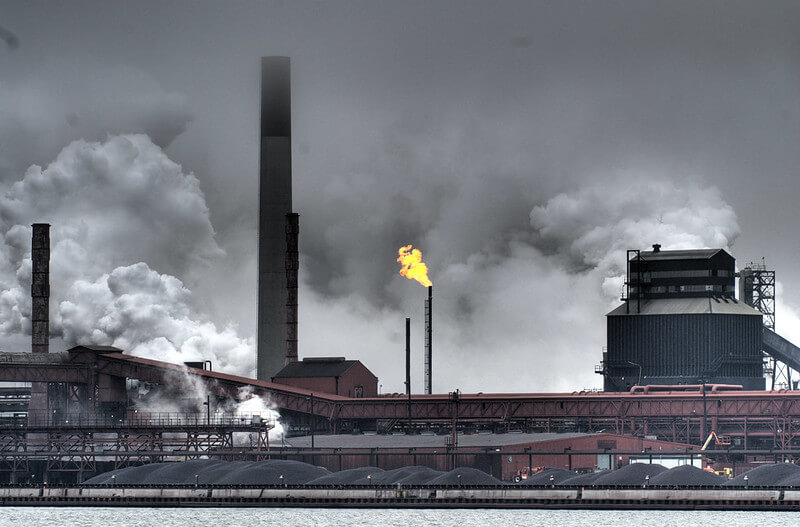Two Canadian steel companies have promised to invest almost $2.5 billion in CO2 reduction projects, instantly transforming themselves from high-polluting greenhouse gas laggards into leaders in the fight against climate change.
The surprising developments happened in July as Algoma Steel and ArcelorMittal Dofasco (AMD) committed to reduce their annual greenhouse gas (GHG) emissions by three million tonnes each within the coming decade.
The magnitude of the $1.765-billion investment by AMD is unprecedented and will secure the company’s future for “yet another generation,” said AMD CEO Ron Bedard at the company’s announcement July 30.
Algoma’s $703-million investment will help to secure “high-paying sustainable jobs for the next 50 years,” said CEO Michael McQuade on July 8, a few days after Prime Minister Justin Trudeau announced the project.
The six-million-tonne reduction by these two companies is equivalent to taking 1.8 million passenger vehicles off the road or wiping out emissions from 1.4 million homes, according to the federal GHG calculator. The promised cuts represent almost 1% of Canada’s annual CO2 emissions – 730 million tonnes in 2019.
What makes these announcements stand out is not only their size but their clearly stated CO2 reduction targets and detailed investment and implementation plans, unusual compared with most decarbonization announcements by Canadian companies.
At three million tonnes, the pledge by Sault Ste. Marie–based Algoma would amount to a 70% cut to its annual CO2 emissions by 2030, which according to the last available report in 2019 were 4.3 million tonnes. The reduction by Hamilton-based AMD would equate to a 60% cut to its yearly GHG releases, reported to be 4.8 million tonnes in 2019.
Ottawa provided major support to these companies to help them make these cuts, driven no doubt by the need to claim progress ahead of the international UN climate change conference in November and an expected federal election this fall.
Included in Algoma’s total investment is a $200-million federal grant and a $220-million loan from the government’s Canada Infrastructure Bank. The AMD investment includes a $400-million federal grant. The AMD grant is contingent on additional funding from the province, but company officials said they expect Ontario to support the project.
Both companies have a history of high CO2 emissions as well as local air pollution problems from smoke, soot and more serious pollutants such as benzene and benzo[a]pyrene – two recognized carcinogens. The CO2 cleanup will also address these pollution issues.
The source of these contaminants is the coke ovens and blast furnaces used to make steel, which will be phased out over the next decade.
Like most large integrated steel manufacturers, AMD and Algoma manufacture steel using large quantities of metallurgical coal, which is heated in ovens to produce carbon-intensive coke. The coke is mixed with iron ore in blast furnaces, where the carbon in the coke binds with oxide impurities, resulting in pure liquid iron – and massive CO2 releases into the atmosphere. The iron is further processed in basic oxygen furnaces or electric arc furnaces (EAFs) to create steel.
AMD’s plan to address this problem involves construction of a new direct reduced iron (DRI) furnace and an EAF, which will replace the company’s coke ovens, blast furnaces and basic oxygen furnace. An existing EAF will remain. The two electric arc furnaces will use low-carbon Ontario electricity to further process the liquid iron into steel using scrap steel. The new furnaces are scheduled to be operational by 2028.
To begin, the DRI furnace will use natural gas to convert iron ore to liquid iron, replacing the current blast-furnace process. The natural gas furnace will reduce measured GHG emissions significantly, though the latest science suggests natural gas’s climate benefits over coal may be reduced by methane leaks from gas sites.
Importantly, however, Bedard said the DRI furnace will be built to enable it to be 100% “hydrogen ready” when hydrogen becomes available sometime after startup. Unlike natural gas, hydrogen can remove oxides from ore with zero CO2 emissions if it is produced with carbon-free electricity. This part of the announcement is still speculative, though, because Ontario has no plans for large-scale hydrogen production.
For its part, Algoma announced construction of two electric arc furnaces that will rely on scrap steel as a feedstock, phasing out its coke ovens and blast furnaces. As with AMD, the company can dramatically reduce carbon emissions using low-carbon Ontario electricity. Construction is expected to take 30 months, and operation is scheduled to begin sometime after that.
While the Algoma and AMD announcements were surprising, they weren’t totally unexpected. Both companies have aging primary plants requiring costly coke-oven and blast-furnace retrofits. At the same time, the federal government’s carbon tax ($170/tonne of CO2 by 2030) promises to make GHG emissions very expensive.
The companies have also made significant investments in their secondary operations recently. AMD has invested $800 million since 2013 in a number of projects, including finishing lines suited to lightweight car steel that will be in demand as automakers switch to electric vehicles.
AMD is a subsidiary of ArcelorMittal, the largest steel company in the world. It has other aggressive climate reduction projects underway in Europe and has recently sold its aging ArcelorMittal USA assets, leaving its operations in Canada and Mexico as its key North American properties.
Algoma has been planning a major restructuring as well, with a $1.1-billion deal with Legato Merger Corp., a New York–based special purpose acquisition company. The plan will provide a significant capital injection into Algoma and facilitate an initial public offering on the Toronto Stock Exchange.
It’s unlikely Algoma and AMD would have approved these major investments without some expectation of government support to address the rising costs and public-image problems of their carbon emissions.
Eugene Ellmen writes about sustainable business and finance. He lives in Hamilton, Ontario.







